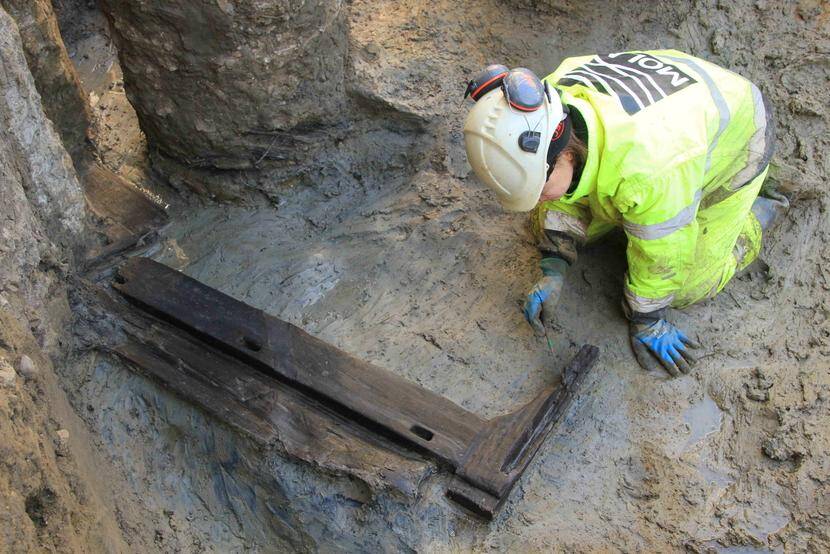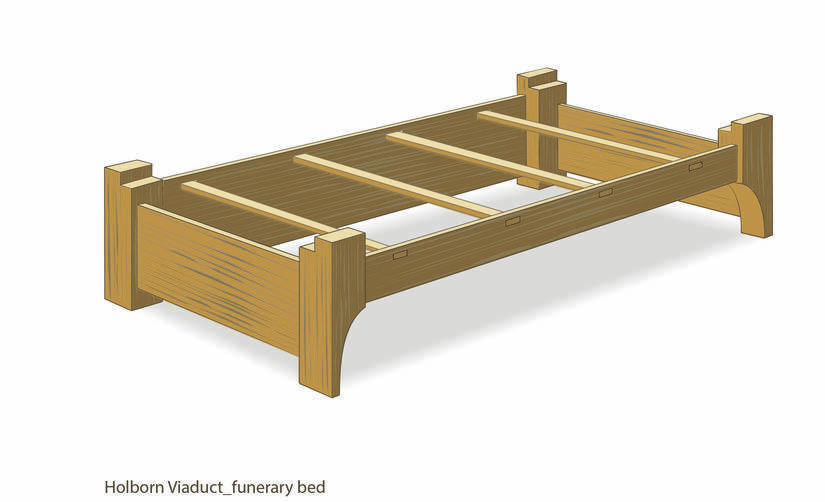The 2,000-year-old funerary bed was incredibly well-preserved — a rarity for wooden objects from the Roman period.

MOLAArchaeologists unearthing the Roman funerary bed.
Archaeologists excavating a construction site in London recently unearthed a fully intact Roman funerary bed, along with skeletal remains and five oak coffins.
The excavation site, which is near Holborn Viaduct in London, will eventually be turned into an office space for the Hogan Lovells law firm. Right now, though, the former Roman cemetery is revealing 2,000 years of London’s history.
An ‘Exceptional’ Piece From 2,000 Years Ago
The bed discovered at the site is of particular interest, as it is the first complete funerary bed ever found in Britain, according to a statement from the Museum of London Archaeology (MOLA).
The funerary bed was taken apart before being buried with the grave, but every piece was recovered. It was made from high-quality oak and has carved feet, as well as several joints fixed with small wooden pegs.

MOLAA reconstruction of the funerary bed.
“It is the only near complete example of a bed to be recovered from Roman Britain and is exceptional in being dismantled and placed in the ground complete,” MOLA finds specialist Michael Marshall told All That’s Interesting via email. “Its cemetery context and its association with human remains should also allow us to explore how furniture might have played a role in funerary practice.”
It is possible that the deceased, an adult male, may have been carried to the site of the burial on top of the funerary bed before it was dismantled and buried alongside his remains.

“Its full significance remains to be determined,” Marshall says. “It might have been a possession of the man or his family, perhaps used during his life or, it may have been specially commissioned and made for funerary use.”
Experts from MOLA believe the funerary bed may have been buried as a grave good, intended for the deceased to use in the afterlife. The museum noted that various tombstones from the Roman Empire feature carvings of the deceased lounging on a couch or bed and eating food as though they were still alive.
“Beds or couches were important pieces of furniture in the Roman world, used for dining and sleeping during life and also in funerary contexts,” Marshall says. “However, until now, the evidence from Roman Britain was limited to depictions in sculpture and a handful of much smaller wooden fragments from settlement sites, or burnt bone and iron elements from early Roman cremation burials.”
‘A Complete Surprise’ — Roman-Era Wooden Objects Are A Rare Find
It is rather rare for archaeologists to unearth wooden objects from archaeological sites, but this location had certain characteristics that allowed the wood to be preserved. The mud is fairly damp, thanks to the site’s proximity to the River Fleet. That moisture kept the wood intact all these years.
“Roman wooden furniture only survives archaeologically under exceptional circumstances,” Marshall says. “The bed was preserved by the wet conditions, close to the river Fleet, and by careful and deliberate burial within a grave.”

MOLAArchaeologists excavating old Roman timber wells.
In the statement, MOLA Project Officer Heather Knight said it was not surprising to find burials at the site, as it is well documented that the Romans buried their dead outside urban centers and along roads.
“However, the levels of preservation we’ve encountered — and particularly uncovering such a vast array of wooden finds — has really blown us away,” she said.
Marshall says the bed is “quite lightweight” compared to similar Mediterranean-style wooden beds, “but the quality of manufacture is very high.”
The bed itself was made from straight-grained oak, “possibly felled from ancient wild woodland,” and its joints are “carefully and competently” made. The bed also features decorative moldings that suggest it was made by a skilled craftsman with “quite sophisticated” woodworking tools.
“There are very few pieces of high quality joinery surviving from Roman Britain, and this rare and well-preserved example reflects the presence of skilled craftspeople,” Marshall says.
Other Objects Found At The Site
Along with the funerary bed, the team recovered several personal objects including amber beads, a glass vial with residue inside, and a decorated lamp dating back to the earliest period of Roman occupation between 43 and 80 C.E., featuring the image of a defeated gladiator.

MOLAThe Roman lamp, amber beads, and glass vial unearthed at the site.
While the exact meaning of this imagery is not known, it is possible that the symbolism of a fallen gladiator had some significance in a funerary context, perhaps representing a fight against death. In any case, it shows that the Romans made some subtle, deliberate choices about how they mourned the dead.
Excavations also revealed that there had once been a second cemetery on the site, dating back to the 16th century. Then, in the wake of the Great Fire of London in 1666, houses, shops, and pubs were erected on the land. Eventually, these were replaced by Victorian warehouses.
Analysis of the finds is still ongoing, as is excavation of the site.
“We also hope to learn more about the life and identity of the man who was buried with the bed, through osteological and scientific analysis of the human remains, and to narrow down the dating of the bed and the burial,” Marshall says. “This will allow us to better understand how this burial fits into the chronological development of funerary practice and set it in the context of similar rites.”
After reading about this surprising Roman-era discovery in London, read about Commodus, the mad Roman emperor depicted in the film Gladiator. Or, check out these 33 ancient Rome facts that will change the way you see history.





